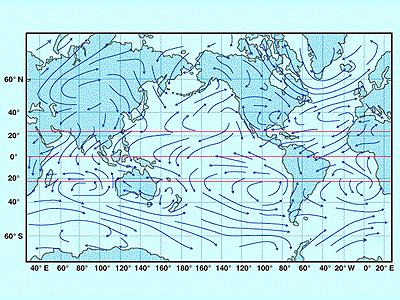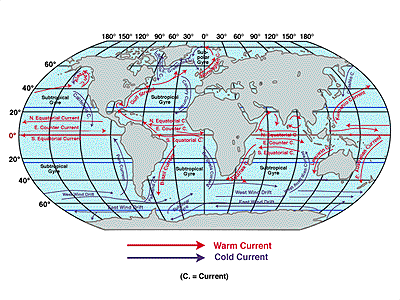CONCEPTS
- Cooler ocean currents cause cooler land temperatures, and warmer ocean currents cause warmer land temperatures in coastal regions.
MATERIALS
- 2 One-gallon glass or plastic jars with lids per group of four students
- 2 Thermometers per group of four students
- String
- Hot tap water
- Cold tap water
- 5 Consecutive days of the weather section of the newspaper
- Graph paper
- Map of the United States
- Maps of winds and wind-driven ocean currents (provided below)
PREPARATION
- This activity works best as a small group activity or as a demonstration.
- Collect several gallon jars. Punch a hole in the lid of each of the jars. The students will need to suspend the thermometers in the jars through their lids.
- Set up one equipment tray for each group. Each tray should have two jars, two thermometers and some string. The students need access to hot and cold tap water. If you are using glass jars, remind the students that the glass will get hot (you might wish to add gloves to the equipment list). Test hot water in the jars before doing the classroom activity to make sure they do not crack.
PROCEDURE
|
|
Engagement
|
|
||
|
Activity
|
||||
|
Explanation
|
EXTENSION
- To test the understanding of the students, give them the global temperature section of the newspaper. Have them locate the cities on a world map and plot the temperatures next to the cities. See if they can determine if the current off each coastline is a warm or a cold water current.
- Alternatively, have your studenst look at the map of surface current that shows warm and cold currents (provided below). They can use this to try to predict the climate of coastal areas throughout the world. Have them compare their predictions to weather and climate data from newspaper, the Internet, or an almanac.
- current: a smooth and steady onward movement of a fluid (i.e., liquid or gas). The part of any body of fluid that has a continuous onward movement.
- hypothesis: an assumption made to account for or relate known facts.
- latitude: location on Earth's surface based on angular distance north or south of the equator. Equator, 0°; North Pole, 90°N; South Pole, 90°S.
- model: system of data, inferences, and relationships, presented as a description of a process or entity.
SOURCE
- Adapted from "Visit to an Ocean Planet" educational CD-ROM, Copyright Caltech and NASA/Jet Propulsion Laboratory
- Orange County Marine Institute, San Juan Capistrano, CA

